In the aftermath of World War I, the torpedo, carried aboard battleships almost since its invention, was removed from the ships of most nations. It was seen as obsolete as improvements in fire control drove up battle ranges, and as the danger posed to the ships by the underwater torpedo flats became more apparent.
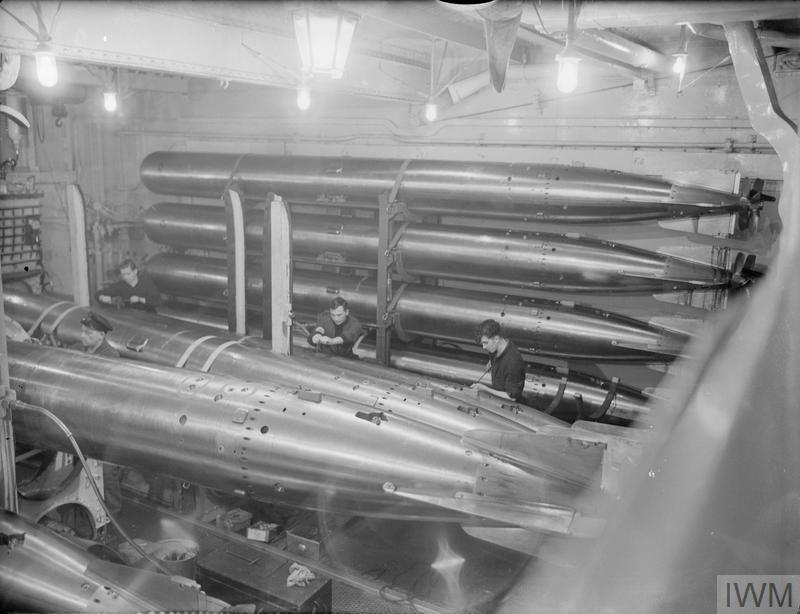
Rodney's torpedo room in 1940
The one exception to this trend was Britain. The last battleships built with torpedoes were Nelson and Rodney, and they had several unique features that deserve close scrutiny. First, their torpedoes were a new design, 24.5" in diameter, the largest ever fitted aboard a battleship. The British, still believing that torpedoes could form an important part of a fleet action, thought that the 21" torpedo had been pushed as far as it could go, and wanted a new design with more room to grow. This growth in size was to be coupled to another technology which offered potentially revolutionary performance. Torpedo propulsion was based around burning fuel and compressed air together, with the compressed air taking up the lion's share of the space and weight due to the need for the air flask. But only 20% of the air was the oxygen needed to support combustion, while the other 80% was inert gasses. The British built specialized plants aboard the ships capable of enriching the air pumped into the torpedoes with extra oxygen,1 offering a significant improvement in performance. During the war, this plant was disabled to keep maintenance burden down, reducing range by about 50%.
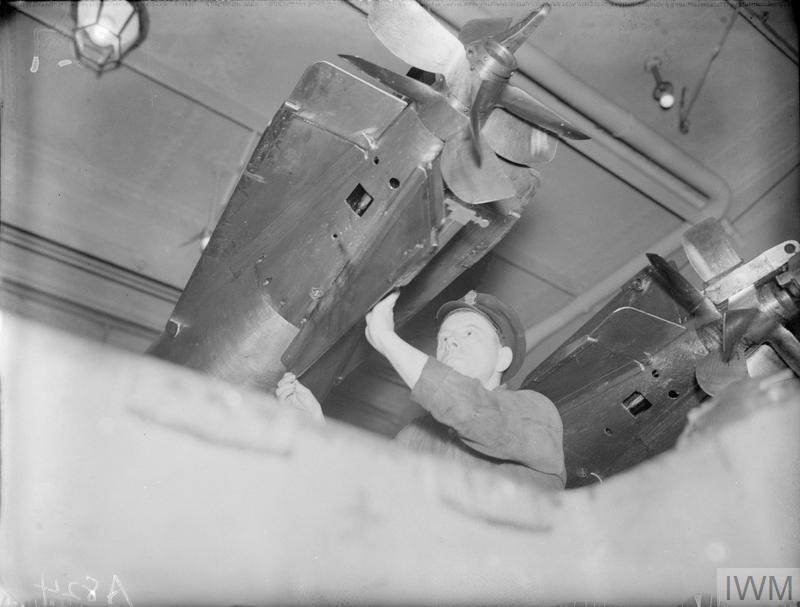
More of Rodney's torpedo room
Another change was in the positioning of the tubes. Normally, the tubes were on the beam, but firing a torpedo out the side of a fast-moving ship was extremely tricky. The US believed it was impossible above 16 kts, which was reasonable in the days of slow battleships, but an increasing problem as ship speeds rose. The solution the British chose was to place the torpedo tubes on either side of the bow, firing about 10° off the centerline. As the torpedo was already aligned with the water, there were no issues with the ship's speed, and the torpedo's gyros could be set to turn it to a new course after launch, giving the equivalent of a broadside. To reduce vulnerability to underwater damage, each tube had its own space, separated from the common torpedo body room where the torpedoes themselves were stored.

Rodney firing on Bismarck
These torpedoes were used only once, in one of the most famous battleship actions ever. During Bismarck's final battle, Rodney fired a number of torpedoes at the German vessel, although the details are a bit unclear. The most comprehensive book I have, Battleship Bismarck by Dulin and Garzke, says that 6 torpedoes were fired from both tubes between 0900 and 0910, and another pair at 0919, all of which missed. A few minutes later, a near-miss jammed the starboard torpedo tube's outer door, putting it out of action for the rest of the battle. Three more were fired from the port tube between 0951 and 0955, and a fourth fired at 0957 was claimed as a hit. Unfortunately, the section of the hull where this torpedo is believed to have struck is buried in the seabed, and so the authors assessed it as a probable hit. If it did occur, it would be the only case of one battleship torpedoing another.
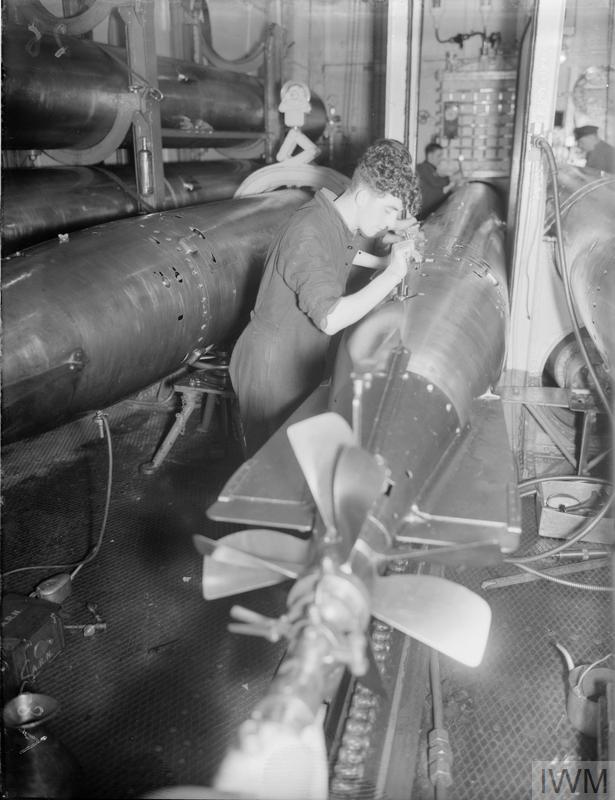
A torpedo under maintenance aboard Rodney
I initially had questions about this narrative, although most were resolved through further research. First, the damage to Rodney’s starboard torpedo tube is not corroborated by either R.A. Burt or Raven & Roberts, and the former work has a specific statement of what Rodney’s damage actually was. Second, both of these works credit the ships with 10 torpedoes, and Dulin & Garzke list 12 being fired, although it is possible that 10 was standard load and either torpedoes were carried in the tubes or there was enough space for an extra pair in wartime.2 Third is the issue of loading time. The last batch of torpedoes credited by Dulin & Garzke has four torpedoes fired in 6 minutes, giving an average reload time of only two minutes per weapon, as the first torpedo was already in the tube. I find this hard to credit, particularly for four weapons in a row. Rodney’s tubes were not too dissimilar to those of submarines, although her torpedo room was considerably larger. It typically took a submarine at least 15 minutes to reload her torpedoes after a salvo, and while some of this can be attributed to tight quarters and the need to reload multiple torpedoes at once, it still seems implausible to move at least two3 5,700 lb weapons from their storage racks into loading position and then into the tubes and get them checked out for firing in two minutes each. Other accounts indicate only two or three torpedoes fired during this time, a much more reasonable number, and fairly typical for a battleship's ready salvo. Other torpedoes could be broken out after they were fired, probably explaining the gap in firing between 0919 and 0951. It's possible that they were able to make use of the ready facilities for the starboard torpedo, although it's unclear from photographs how easily torpedoes could be moved back and forth.4
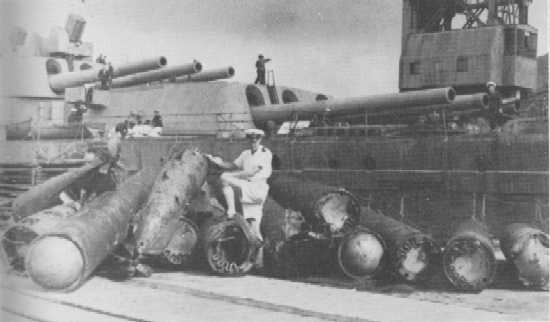
Wrecked torpedoes being unloaded from Nelson after she was torpedoed in 1941
While Rodney’s torpedoes saw action, Nelson’s proved a hindrance during the war. On December 4th, 1939, she was mined while entering port, and the torpedo spaces flooded. They were apparently repaired at this time, only to be wrecked again by an Italian aerial torpedo on September 27th, 1941. In neither case did the torpedo installation appear to make the matter worse, but it does not seem that Nelson’s was repaired after the second attack. The exact fate of Rodney’s torpedoes is unclear, but most sources agree that they were deactivated some time in 1943 or 1944.
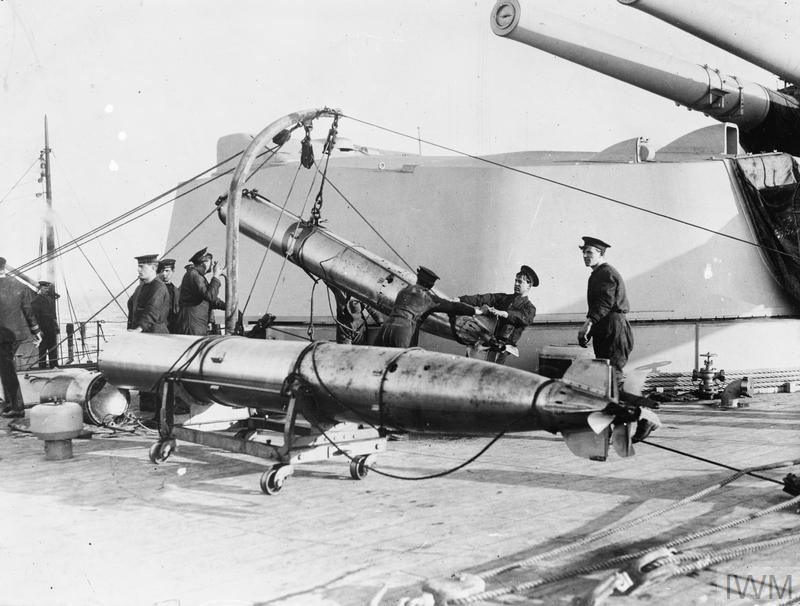
Torpedoes being loaded aboard Royal Oak during WWI
Nor did the British interest in torpedoes fade in the years after the Nelsons were completed. The rationale was their value in close-range action, and in making an enemy potentially reluctant to close the range against them. Around 1929, the aft torpedo room of most of the older battleships was deleted due to concerns about flooding, recently illustrated in an incident aboard Warspite where water came in through a torpedo tube, and five years later, there was discussion of deleting all underwater tubes and possibly replacing them with above-water tubes. This was ultimately not generally done at the time, as the torpedoes were seen as valuable for the night-fighting capability the RN was working hard to create. Royal Oak was refitted and received above-water tubes, but they were simply deleted from all other battleships that underwent major refits, probably due to the demands of the upcoming war on the Dockyards.
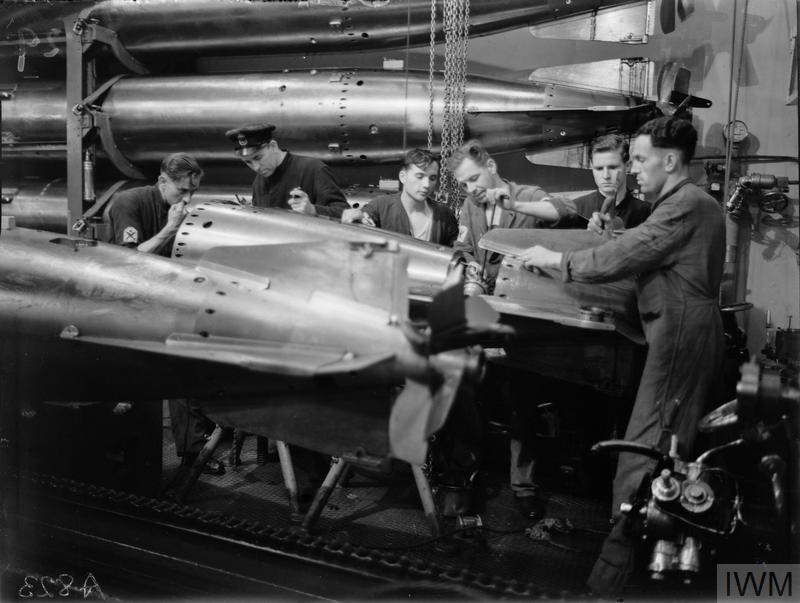
A torpedo motor is worked on aboard Rodney
The interest in torpedoes at the Admiralty extended even to the new battleships. A quintuple above-water tube was part of the initial specification for the ships that eventually became the King George V class, and fixed above-water tubes and even groups of three underwater tubes were also investigated, although the KGVs ultimately became the first British battleships to complete without torpedo tubes since the turn of the century. Despite this, two quintuple torpedo tubes were even included in the Battleship 1945 design, built to reflect the lessons of the war, and there were serious proposals to mount similar tubes in the spaces vacated when the aviation facilities of the KVGs were deleted.
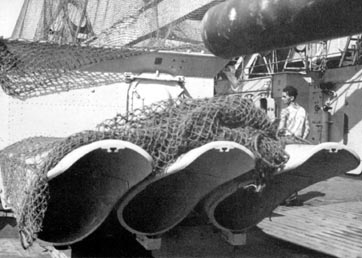
Torpedoes aboard Scharnhorst
Despite this, the British were not actually the last to put torpedoes aboard the battleships. In 1941, after their return from their Atlantic cruise, Scharnhorst and Gneisenau were each fitted with a pair of triple torpedo tubes taken from light cruisers, while Tirpitz received a pair of quad tubes. These were intended not for fleet actions, but for sinking merchant ships during commerce raiding. AP shellfire is not particularly effective at letting water into ships, and a raider has limited amounts of time and ammunition to work with, so above-water tubes were fitted. No fire-control equipment or dedicated crew was provided, as the tubes were only to be used at close range on stationary targets.
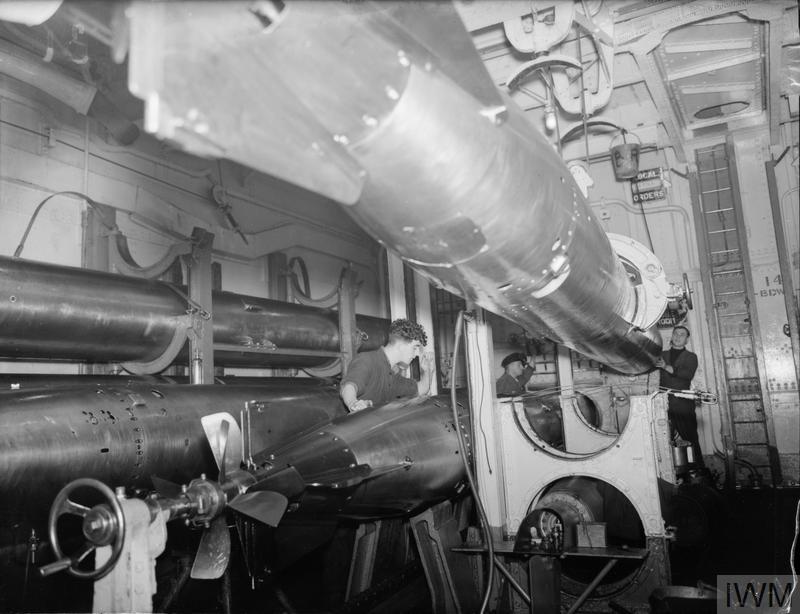
Rodney's crew loads a torpedo, and lowers another into position for loading
Throughout the history of the battleship, the torpedo was both the greatest threat and a major weapon, although an oft-overlooked one. Tucked out of sight, either in a ship's side or under the waterline, and rarely used operationally, it has none of the glamor of big guns, but it was important despite that. Several nations even looked at building ships primarily armed with torpedoes, and although none of these ever came to fruition, the resulting designs are interesting enough to deserve a separate discussion.
1 The exact value, weirdly enough, is something I can't find in my sources. ⇑
2 This was subsequently confirmed by a footnote to a report of later damage to Nelson, which listed 12 torpedoes aboard her four months later. ⇑
3 Torpedo one was already in the tube and torpedo two would presumably be on the skids right behind the tube. ⇑
4 Demands for a higher rate of fire were common in the battleships, to the point where a German officer once proposed a giant rotating drum with several torpedoes in it which could be fired in quick succession. This would have been tremendously costly in space and weight, and even the Germans discarded the plan out of hand. ⇑

Comments
I feel like "Her torpedo room is considerably larger" is an understatement. That space is huge. (I say that without even comparing it to the torpedo room on a WW2 sub, which from my experience feels about twice the diameter of a torpedo.)
While I agree that 2 minutes per fish seems unlikely, I'l like to point out two items that would have sped the process - the ability to have one torpedo in the adjacent loading rack (presumably quicker to hoist from) but more importantly a double crew. If there were two hoists, one crew could essentially work offset from the other, hoisting the torpedo from the left rack while the other crew was lowering and readying the torpedo from the right rack to go forward.
Didnt the Japanese build a light cruiser dedicated to torpedoes. Had something like 16 tubes on it?
@Chuck
That's a good point about the double crew. It still seems fast to me, but it's not complete nonsense. Part of this is me going from "something is deeply wrong here" to "I guess this could have happened", and there are still traces of the first position in the text.
@timshatz
You're thinking of the light cruisers Kitakami and Oi, which were fitted with 40 torpedo tubes, 5 quads on each side. The tubes were landed in the early months of the Pacific War.
The British built specialized plants capable of enriching the air pumped into the torpedoes with extra oxygen,1 offering a significant improvement in performance. During the war, this plant was disabled to keep maintenance burden down, reducing range by about 50%.
I take it that these plants were on board the ships, not just a factory in Southern England where they went on holiday during the war to reduce maintenance costs?
Meanwhile, the British took to launching in the forwards direction (easier to launch) and then guiding the torpedoes into a turn and hence towards the enemy. Anticipating the approach of the VLS rockets.
And may I just wince at the sight of a pile of damaged, and hence probably super unstable torpedos and some guy just hops on top for a photo opportunity. Jumping onto a smashed 500 lb high explosive warhead. Kicking a cracked compressed oxygen bottle.
Correct. Sorry if that wasn't completely clear.
The interesting thing is that gyro angling was first really used by the Americans, who fitted some of their destroyers with two quad tubes on each broadside, and planned to curve them so that they could get 16 torpedoes in a salvo. But yes, I suppose there are shades of VLS.
And I suspect that the torpedoes had been rendered safe before they were pulled out. The British of WWII were very paranoid about explosives safety for obvious reasons.
Why does it seem like everything the IJN used to kill USN servicemen in the Pacific originated with Britain?
I don't know who to blame more, Semphill for teaching the IJN how to do carrier aviation, Cunningham for giving them the whole port strike idea, Thurston for designing Kongo, or whoever invented the heavy long-range oxygen-propelled torpedo for the Nelsons.
Didn't the Japanese decide to copy the Royal Navy (and the German army) when they were modernising? Perhaps that lead them to keep an eye on the British and swiftly adopt their innovations. I think there was also an Anglo-Japanese alliance in the early 20th century, which in presumably the British (and Americans) ended up regretting.
@Chris
That's basically because the British were on the forefront of naval warfare in the first 2 decades of the 20th century, and the Japanese quite rightly chose to imitate them as the best way to get a better navy.
Anglo-Japanese alliance of 1906.
Japan were among the allies of 1914-18, purchased heavily and were influenced by British naval practice. Later they went their own way, leading the world briefly in Naval Aviation.
There were a lot of technical innovations between the wars, with navies seeking marginal gains while attempting/pretending to adhere to the London/Washington treaty limits.
I think we can credit the Japanese with the Type 93 torpedo. Everybody knew Oxygen was the beter fuel, only the Japanese made it work.
Oxygen isn't a fuel (unless you're running a big star) but something you use to burn a fuel.